 W
WA Butsudan , sometimes spelled Butudan, is a shrine commonly found in temples and homes in Japanese Buddhist cultures. A butsudan is either a defined, often ornate platform or simply a wooden cabinet sometimes crafted with doors that enclose and protect a Gohonzon or religious icon, typically a statue or painting of a Buddha or Bodhisattva, or a calligraphic mandala scroll.
 W
WChabudai is a short-legged table used in traditional Japanese homes. The original chabudai ranged in height from just 15 cm to a maximum height of 30 cm. People seated at a chabudai may sit on zabuton or tatami rather than on chairs. The four legs of a chabudai are generally collapsible so that the table may be moved and stored easily.
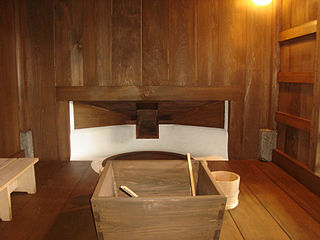 W
WFuro , or the more common and polite form ofuro , is a Japanese bath and/or bathroom. Specifically it is a type of bath which originated as a short, steep-sided wooden bathtub. Baths of this type are found all over Japan in houses, apartments and traditional Japanese inns (ryokan) but are now usually made out of a plastic or stainless steel.
 W
WIn Japanese architecture, fusuma are vertical rectangular panels which can slide from side to side to redefine spaces within a room, or act as doors. They typically measure about 90 cm wide by 180 cm tall, the same size as a tatami mat, and are 2–3 cm (0.79–1.18 in) thick. The heights of fusuma have increased in recent years due to an increase in average height of the Japanese population, and a 190 cm height is now common. In older constructions, they are as small as 170 cm high. They consist of a lattice-like wooden understructure covered in cardboard and a layer of paper or cloth on both sides. They typically have a black lacquer border and a round finger catch.
 W
WFuton is the Japanese traditional style of bedding.
 W
WA Futon dryer is an electric device that warms and dries a Japanese futon by forcing warm air through it.
 W
WGenkan are traditional Japanese entryway areas for a house, apartment, or building, a combination of a porch and a doormat. It is usually located inside the building directly in front of the door. The primary function of genkan is for the removal of shoes before entering the main part of the house or building.
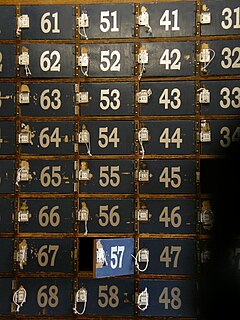 W
WA getabako (下駄箱) is a shoe cupboard in Japan, usually situated in the genkan, an entryway or porch of the house. This is often called a cubby in the United States. In Japan, it is considered uncouth to not remove one's shoes before entering the house. Near the getabako is a slipper rack, and most people in Japan wear slippers around the house, except for rooms which have tatami flooring, as they are bad for the floor. The getabako is usually made of wood and bamboo, and there are many sold all over the world.
 W
WThe hibachi is a traditional Japanese heating device. It is a brazier which is either round, cylindrical, or box-shaped, open-topped container, made from or lined with a heatproof material and designed to hold burning charcoal. It is believed hibachi date back to the Heian period. It is filled with incombustible ash, and charcoal sits in the center of the ash. To handle the charcoal, a pair of metal chopsticks called hibashi is used, in a way similar to Western fire irons or tongs. Hibachi were used for heating, not for cooking. It heats by radiation, and is too weak to warm a whole room, often disappointing foreigners who expected such power. Sometimes, people placed a tetsubin over the hibachi to boil water for tea. Later, by the 1900s, some cooking was also done over the hibachi.
 W
WAn irori is a traditional Japanese sunken hearth. Used for heating the home and for cooking food, it is essentially a square, stone-lined pit in the floor, equipped with an adjustable pothook – called a jizaikagi (自在鉤) and generally consisting of an iron rod within a bamboo tube – used for raising or lowering a suspended pot or kettle by means of an attached lever which is often decoratively designed in the shape of a fish.
 W
WKamidana are miniature household altars provided to enshrine a Shinto kami. They are most commonly found in Japan, the home of kami worship.
 W
WThe kamiza is the "top seat" within a room, meaning the seat of honor; the term also applies to the best seats in air-planes, trains, and cars. The antonym, meaning "bottom seat," is shimoza (下座). In a room, the kamiza is the seat or position that is most comfortable, usually furthest from the door – because this is warmest, and was safest from attack back in the feudal period. In a traditional washitsu room it would often be a zabuton placed so the person sitting there has his back to the tokonoma; the kamiza is the spot closest to the tokonoma or simply farthest from the door in a room lacking a tokonoma. In a Western-style room it would be a comfortable armchair or sofa, or the head of a table. The term is general, and does not only apply to Japanese culture.
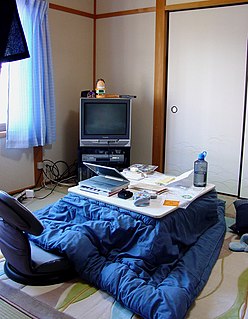 W
WA kotatsu is a low, wooden table frame covered by a futon, or heavy blanket, upon which a table top sits. Underneath is a heat source, formerly a charcoal brazier but now electric, often built into the table itself. Kotatsu are used almost exclusively in Japan, although similar devices for the same purpose of heating are used elsewhere, e.g. the Spanish brasero or Iranian korsi.
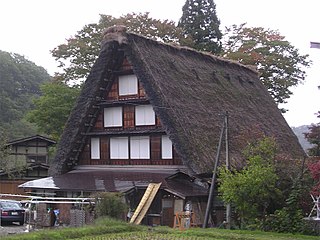 W
WMinka are vernacular houses constructed in any one of several traditional Japanese building styles. In the context of the four divisions of society, Minka were the dwellings of farmers, artisans, and merchants. This connotation no longer exists in the modern Japanese language, and any traditional Japanese-style residence of appropriate age could be referred to as Minka.
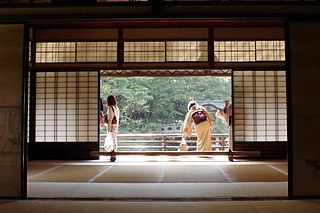 W
WA shōji is a door, window or room divider used in traditional Japanese architecture, consisting of translucent sheets on a lattice frame. Where light transmission is not needed, the similar but opaque fusuma is used. Shoji usually slide, but may occasionally be hung or hinged, especially in more rustic styles.
 W
WSudare are screens or blinds. They are sometimes called misu as well, particularly if they have a green fabric hem. Sudare are made of horizontal slats of decorative wood, bamboo, or other natural material woven together with simple string, colored yarn, or other decorative material to make nearly solid blinds. They could be either rolled or folded up out of the way. Yoshizu, non-hanging type sudare, are made of vertical slats of common reed and used as screen.
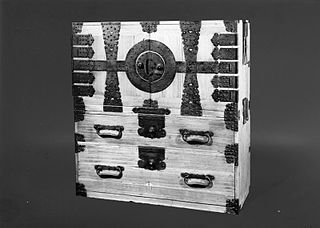 W
WTansu is the traditional mobile storage cabinetry indigenous to Japan. Tansu was first recorded in the Genroku era of the Edo period (1688–1704). The two characters, tan and su, appear to have initially represented objects with separate functions: the storage of food and the carrying of firewood. Since the radical for bamboo appears in each of these characters, it may be conjectured that wood was not as yet used.
 W
WA tatami (畳) is a type of mat used as a flooring material in traditional Japanese-style rooms. Tatamis are made in standard sizes, twice as long as wide, about 0.9 m by 1.8 m depending on the region. In martial arts, tatami are the floor used for training in a dojo and for competition.
 W
WSome toilets in Japan are more elaborate than toilets commonly found in other developed nations. The current state of the art for Western-style toilets in Japan is the bidet toilet, which, as of March 2016, is installed in 81% of Japanese households. In Japan, these bidets are commonly called washlets, a brand name of Toto Ltd., and include many advanced features rarely seen outside of Asia. The feature set commonly found on washlets are anal hygiene, bidet washing, seat warming, and deodorization. Japanese toilets are well known in popular culture and often parodied in comedic works set in Japan.
 W
WA tokonoma , or simply toko (床), is a recessed space in a Japanese-style reception room, in which items for artistic appreciation are displayed. In English, a tokonoma could be called an alcove.
 W
WA washitsu (和室), meaning "Japanese-style room(s)", and frequently called a "tatami room" in English, is a Japanese room with traditional tatami flooring. Washitsu also usually have sliding doors (fusuma), rather than hinged doors between rooms. They may have shōji and, if the particular room is meant to serve as a reception room for guests, it may have a tokonoma.
 W
WA zabuton is a Japanese cushion for sitting. The zabuton is generally used when sitting on the floor and may also be used when sitting on a chair. In a more casual setting, the zabuton can be used in conjunction with a zaisu, a type of Japanese legless chair, with or without an accompanying kyōsoku (脇息), a Japanese-style armrest. Ordinarily, any place in Japan where seating is on the floor will be provided with zabuton for sitting comfort. A typical zabuton measures 50–70 cm square and is several centimetres thick when new.
 W
WA zaisu (座椅子) is a Japanese chair with no legs but a normal chair back. They are often found in traditional rooms with tatami mats, and are often used for relaxing under heated kotatsu tables.